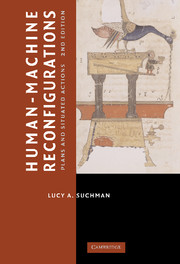Book contents
- Frontmatter
- Contents
- Acknowledgments
- Preface to the 2nd Edition
- Introduction
- 1 Readings and Responses
- 2 Preface to the 1st Edition
- 3 Introduction to the 1st Edition
- 4 Interactive Artifacts
- 5 Plans
- 6 Situated Actions
- 7 Communicative Resources
- 8 Case and Methods
- 9 Human–Machine Communication
- 10 Conclusion to the 1st Edition
- 11 Plans, Scripts, and Other Ordering Devices
- 12 Agencies at the Interface
- 13 Figuring the Human in AI and Robotics
- 14 Demystifications and Reenchantments of the Humanlike Machine
- 15 Reconfigurations
- References
- Index
10 - Conclusion to the 1st Edition
Published online by Cambridge University Press: 05 June 2012
- Frontmatter
- Contents
- Acknowledgments
- Preface to the 2nd Edition
- Introduction
- 1 Readings and Responses
- 2 Preface to the 1st Edition
- 3 Introduction to the 1st Edition
- 4 Interactive Artifacts
- 5 Plans
- 6 Situated Actions
- 7 Communicative Resources
- 8 Case and Methods
- 9 Human–Machine Communication
- 10 Conclusion to the 1st Edition
- 11 Plans, Scripts, and Other Ordering Devices
- 12 Agencies at the Interface
- 13 Figuring the Human in AI and Robotics
- 14 Demystifications and Reenchantments of the Humanlike Machine
- 15 Reconfigurations
- References
- Index
Summary
The theme of the original text of Plans and Situated Actions was in one sense an obvious proposition, that insofar as actions are always situated in particular social and material circumstances, the situation is crucial to action's interpretation. The very obviousness of this fact about action contributes to the ways in which it has been overlooked. The intellectual tradition of the cognitive sciences, in particular applied logic, has taken abstract structural accounts as the ideal representational form. An adequate account of any phenomenon, according to this tradition, is a formal theory that represents just those aspects of the phenomenon that are true regardless of particular circumstances. This relation of abstract structures to particular instances is exemplified in the relation of plans to situated actions. Plans are taken to be either formal structures that control situated actions or abstractions over instances of situated action, the instances serving to fill in the abstract structure on particular occasions. The research strategy in cognitive science has been to represent mental constructs, such as goals or plans, then stipulate the procedures by which those constructs are realized as action or recognized as the actor's intent. The specification of procedures for action, in turn, has presupposed enumeration of the conditions under which a given action is appropriate. These stipulated conditions, ready made and coupled to their associated actions, take the place of a lively, moment-by-moment assessment of the significance of particular circumstances.
- Type
- Chapter
- Information
- Human-Machine ReconfigurationsPlans and Situated Actions, pp. 176 - 186Publisher: Cambridge University PressPrint publication year: 2006



